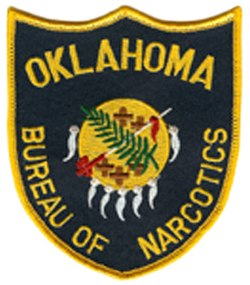Oklahoma Bureau of Narcotics

Bureau of Narcotics and Dangerous Drugs Control patch
|
|
| Agency overview | |
|---|---|
| Formed | May 15, 1975 |
| Jurisdiction | Government of the state of Oklahoma |
| Headquarters | Oklahoma City, Oklahoma |
| Employees | 121 classified 14 unclassified |
| Annual budget | $13.9 million |
| Minister responsible | |
| Agency executives |
|
| Website | www.ok.gov/obndd/ |
The Oklahoma Bureau of Narcotics and Dangerous Drugs Control (OBN), often shortened to Oklahoma Bureau of Narcotics, is an agency of the government of Oklahoma charged with minimizing the abuse of controlled substances through law enforcement measures directed primarily at drug trafficking, illicit drug manufacturing, and major suppliers of illicit drugs.
The Bureau is governed by a seven-member Commission, who members are appointed by the Governor of Oklahoma, with the approval of the Oklahoma Senate. The Commission is responsible for appointing a Director of OBN to serve as the chief executive officer of the Bureau. The agency is currently under the leadership of John Scully, whom was appointed Director in March of 2016 by the aforementioned Commission.
The Bureau of Narcotics was created in 1975 during the term of Governor David L. Boren.
In 1953, the Oklahoma Legislature created the agency specifically to enforce drug laws. Designated the Division of Narcotics Enforcement, the agency operated under the Attorney General of Oklahoma for the next decade. Then in 1964, the Division of Narcotics Enforcement became a casualty of political conflict between the Attorney General and the Speaker of the Oklahoma House of Representatives. The Division was abolished and created under the name of the Oklahoma Bureau of Narcotics. This new Bureau was placed under the direct command of the Governor of Oklahoma. This new arrangement would last for four years.
Beginning in the late 1960s, narcotics operations and drug-related crimes accelerated at a frightening pace. Despite a merger into the Oklahoma State Bureau of Investigation (OSBI) in 1968, only one full-time narcotics agent was employed by the state. Recognizing this problem, the Legislature granted OSBI funds to establish a full-time narcotics unit, but by the early 1970s. the unit had been proven a failure. In response, the Legislature passed the Uniform Control Dangerous Substances Act of 1971. The Act established the Commissioner of Narcotics and Dangerous Drugs Control under the direction of the Attorney General. The Commissioner was responsible for the state's general interest in controlled drugs but actual enforcement of the Controlled Substances Act was left to the OSBI.
...
Wikipedia
